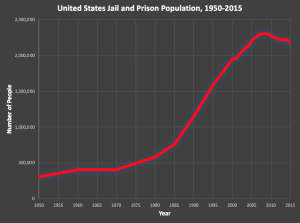
On October 27, 1986, Republican President Ronald Reagan signed the Anti-Drug Abuse Act of 1986. The Act, with the overall “War on Drugs,” drove the Untied States to incarcerate a large proportion of its population. The number of those in prison or jail rose from about 500,000 in 1980 to nearly 2.3 million in 2013.
The Act created a more punitive probation system and enacted new mandatory minimum sentences for drugs, including marijuana, which included significant disparity in the sentences imposed for crimes involving powder cocaine versus those involving crack cocaine (where mandatory minimum sentences were set at a 100:1 ratio).
For example, a drug crime involving five grams of crack cocaine resulted in a mandatory minimum sentence of five years in federal prison, while crimes involving up to 500 grams of powder cocaine received a lower sentencing recommendation.
“This sentencing disparity was not based on credible scientific evidence about a differing biological impact between cocaine in powder form versus crack form, but it had clear racial results,” according to the Equal Justice Initiative.
“In the years following the enactment of the Anti-Drug Abuse Act, the number of Black people sent to federal prison ballooned from approximately 50 in 100,000 adults to nearly 250 in 100,000 adults. During the same period, there was almost no change in the number of white people incarcerated in federal prison.”




The over-representation of Black Americans in the justice system is well documented. Black men constitute about 13 percent of the male population, but about 35 percent of those incarcerated.
One in five Black people born in 2001 is likely to be incarcerated in their lifetime, compared to one in 10 Latinx people and one in 29 white people.
Studies have found that Black people are more likely to be stopped by the police, detained pretrial, charged with more serious crimes, and sentenced more harshly than white people — even when controlling for things like offense severity.
Additionally, women now make up almost one out of every four jail admissions, up from fewer than one in 10 in 1983. Since 1970, the number of women in U.S. jails has increased 14-fold — from fewer than 8,000 to nearly 110,000 in 2013.
To accommodate those new prisoners, more than 168 state and 45 Federal prisons were built to increase the number of such institutions to about 1,500 by the mid-1990s. Several new prisons were built in the Adirondacks during this time.
Since 1970, the total jail population in New York has increased by about 47%. Essex County has had the greatest increase in jail population from 2005 to 2015 with a rise of 347%.
Since 1983, the state’s prison population has increased 53%.
Illustrations, from above: President Ronald Reagan signs the Anti Drug Abuse Act of 1986; and US jail and Prison population, 1950-2015.
This post was originally published on this site be sure to check out more of their content.









